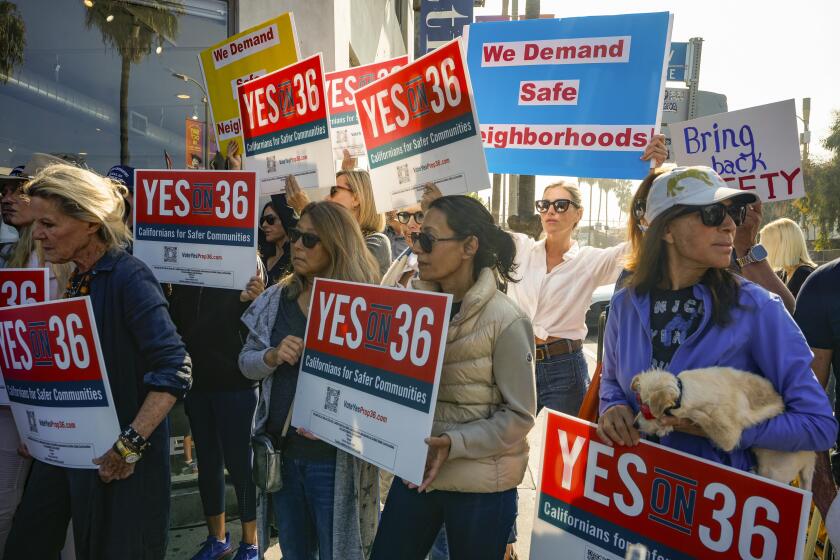Must Reads: Will Newsom end oil drilling in California? Many environmentalists are betting yes

- Share via
Reporting from Sacramento — California’s legacy of oil drilling should be just that, many environmentalists argue — relegated to the history books.
They are urging Gov. Gavin Newsom to ban new oil and gas drilling in California and completely phase out fossil fuel extraction in one of the nation’s top petroleum-producing — and gasoline-consuming — states.
At the least, they want the state to impose buffer zones prohibiting new oil and gas wells near schools, hospitals and residential neighborhoods and also require monitoring for potentially hazardous emissions from abandoned or plugged wells, proposals already being considered by state lawmakers.
“It sure would make us happy if he made a big splash about this. It’s month four. People are being very patient. By month six, patience may wear thin,” said Sierra Club California Director Kathryn Phillips.
Phillips said her organization and other groups that support curtailing oil production in California have met informally with Newsom administration officials. While Newsom has not made any promises, expectations remain high, she said.
Newsom, who served on the state lands commission for eight years, says he’s well versed in the issues surrounding on-shore and off-shore oil drilling in California and said he would announce his administration’s detailed strategy on energy policy in the next few weeks.
The governor was coy about core aspects of that policy, and declined to say if it would ban the controversial practice of hydraulic fracking, a process that uses drilling and large volumes of high-pressure water to extract gas and oil deposits.
“I’m taking a very pragmatic look at it, in scoping this,” Newsom told The Times last week. “It’s also an inclusive scoping because it includes people in the industry, that have jobs; communities that are impacted from an environmental justice prism but also from an economic justice prism. It’s a challenging issue. There’s a reason Gov. Brown used a lot of dexterity on this issue.”
The Democratic governor emphasized that he would not be “exercising passivity.” But Newsom also said that, despite his strong support for putting California on a path to a 100% renewable energy supply, it would be unrealistic to think that California can just stop its dependence on oil and gas.
“One cannot just turn off the switch. One cannot just immediately abut against a century of practice and policy,” Newsom said.

Q&A: Gavin Newsom on his ‘mayoral mind-set’ in first 100 days in office »
Though his campaign was endorsed by influential environmental groups that support curtailing oil production, Newsom must weigh the potential, widespread economic impact of undercutting a billion-dollar industry in the state. While oil production in California has been on the decline in recent years, California in 2017 was the nation’s fifth-largest crude oil producer among the nation’s 50 states, federal figures show.
Newsom also has a long personal and financial history with the heirs of the Getty Oil family. The governor’s father, the late William Newsom, was a longtime friend and former high school classmate of Gordon Getty, son of oil magnate J. Paul Getty, and managed the Getty family trust. Gordon Getty also was a longtime financial benefactor to Gavin Newsom, and for decades they were in the winery and hospitality business together. (The governor put those investments in a blind trust after he was elected in November.)
Catherine Reheis-Boyd, president of the Western States Petroleum Assn., says Newsom will take a pragmatic approach. Oil production in California helps support 368,000 “blue-collar jobs with high wages,” she said, and the state still will depend on oil and gas for fuel and energy even during its long-term transformation to a 100% renewable energy supply.
“We have, I think, close to 40 million people in the state who drive 26 million vehicles with internal-combustion engines,” Reheis-Boyd said. “You cannot have a policy that stops production of oil in California for quite some time.”
Reheis-Boyd also noted that California has some of the most strict regulations and environmental protections in the world. If the state decides to shut down oil production, it will be forced to import oil from states and countries with much lower health, environmental and safety standards — increasing risks posed to those populations.
“Without domestic oil, it would mean we would have to import oil from other countries. Now you’re looking at more truck emissions, more ship emissions, possible oil pipeline mishaps. It’s counterproductive,” said Bill La Marr, executive director of the California Small Business Alliance, which has a membership of 26,000 companies statewide.

La Marr said phasing out oil production in the state would also increase fuel prices, driving up costs for business owners and, ultimately, consumer goods.
“In the end, it’s a tax on consumers,” he said. “Most hardworking people can’t afford a brand-new Prius or a Tesla. They rely on the internal-combustion engine.”
During the 2018 gubernatorial campaign, Newsom said he opposed fracking because it posed possible health and environmental risks. Brown, his predecessor, approved restrictions on fracking but environmentalists criticized him for balking at an outright ban of fracking, saying he thought the practice might offer California some economic opportunities.
The effort to sway Newsom mimics the unsuccessful campaign by the so-called Brown’s Last Chance Coalition supported by environmental activists, community groups, labor unions and that tried to persuade Brown to freeze all new oil and gas drilling during his final year in office. Brown, who prided himself in helping California become a world leader in combating climate change and championing renewable energy, bristled at accusations that his environmental record was tarnished by a failure to take on California’s powerful oil industry.
Newsom noted that, just two days after he won the November election, those same activists held a protest outside of his house in Marin County blocking his driveway.
“My wife went down and said hello to them, spent time with them,” Newsom said. “So I’m very familiar with the debate.”
Members of the organization, Idle No More SF Bay, disputed Newsom’s characterization of what occurred. In an email to the Times, they said they gathered outside his home in Marin County shortly before Christmas and were singing holiday songs and encouraging Newsom to be a climate “hero,” not protesting. They said they did not block the Newsom’s driveway.
Kassie Siegel of the Center for Biological Diversity said she has more confidence in Newsom than she did in Brown.
In 2018, Newsom joined other State Lands Commission members in protesting President Trump’s efforts to open the coast to offshore oil drilling, saying in a letter the move “creates undeniable peril to California’s ocean and marine environment and economy” and poses an unacceptably high risk of “catastrophic harm from an offshore oil spill.”
“He’s also been very good at pushing back hard at Trump’s climate change denials,” said Siegel, who heads the center’s climate law institute. “We need him to take that bold approach when it comes to the oil industry.”
Siegel and others say the Newsom administration should take a first step of creating health and safety buffers around oil and gas wells in urban areas.
California is home to 72,000 oil-producing wells that, in 2018, produced 165.3 million barrels of oil from both on-shore and off-shore facilities, according to the California Department of Conservation. California also consumes more gasoline than any other state — 366,000 barrels in 2017, according to U.S. Energy Information Administration.
In 2018, the Los Angeles County Department of Public Health called for greater health and safety “setback” requirements on new oil and gas wells, keeping them at least 300 feet from populated areas. It also called for a significant increase in air quality monitoring within the 68 active oil fields in the Los Angeles Basin. Oils rigs, storage tanks and other operations are common sights in the working-class neighborhoods in Wilmington, Long Beach, Torrance and South Los Angeles, where oil production has plagued neighborhoods with foul odors, noise and occasional spills or refinery explosions.
Close to 900,000 Californians live within a half-mile of an active oil or gas well, with the vast majority in Los Angeles and Kern counties, according to a study by the Environmental Defense Fund. There also are 378 schools or certified daycare facilities in California that are that close to an active well, the report found.
The most publicized and politically charged case highlighting the dangers of oil and gas extraction in Southern California was in 2015, when a gas leak at the affluent San Fernando Valley community of Porter Ranch caused thousands of residents to evacuate and triggered complaints of nosebleeds, nausea and headaches. The Southern California Gas Co. agreed to pay $119.5 million to settle lawsuits brought by state and local agencies.
Assemblyman Al Muratsuchi (D-Rolling Hills Estates) introduced legislation in February to ban any new oil and gas wells, or idle wells that are redrilled, to be located with a half-mile of a residence, school, playground or a healthcare facility. Muratsuchi said he’s been focused on the issue ever since voters in Hermosa Beach blocked efforts to drill wells within 100 feet of homes.
Residents in less affluent areas should have the same protections, he said. Even in oil-rich Texas, some cities have mandatory setbacks for wells in residential areas, he said.
“The question should not be whether to have a setback requirement. The issue should be how much,” Muratsuchi said. “I think of regardless of how much we settle upon, the evidence is crystal clear that we do need to have some setback to protect our most vulnerable communities.”
Twitter: @philwillon
More to Read
Get the L.A. Times Politics newsletter
Deeply reported insights into legislation, politics and policy from Sacramento, Washington and beyond. In your inbox twice per week.
You may occasionally receive promotional content from the Los Angeles Times.










